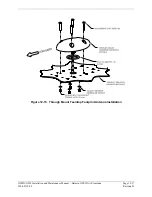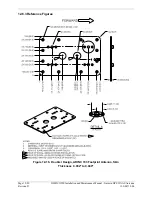
G900X/G950 Installation and Maintenance Manual – Garmin GPS WAAS Antenna
Page 12-7
190-00719-00
Revision D
12.5.4 Buried Antennas (Below the skin covering or Glare Shield)
NOTE
Garmin’s GIA 63W WAAS GPS receiver requires that supported GPS antennas be
mounted external to the aircraft in accordance with section 12.5.3 to assure adequate
WAAS system performance as specified by TSO-C146A and C145A. Installations using
buried antennas do so at their own risk. Garmin cannot ensure suitable TSO-
C146A/145A performance can be demonstrated using such a configuration (GPS signal
reception problems may exist).
Most IFR certified installations do not make use of buried antennas. There are potential performance
issues related to buried antennas that the kit builder / installer should be aware of prior to electing to
install buried antennas which are used for primary navigation equipment (TSO-C154A/C146A WAAS).
•
Some gain of the antenna may be lost as the signal needs to penetrate through the skin of the
aircraft. The loss may not be apparent to you, but under the some of the worst case signal
scenarios LPV and approach availability may be affected.
•
The materials in some aircraft are not suitable for GPS signals to penetrate, care should be taken
to properly modify the aircraft structure to accommodate this. Modifications of this sort are not
recommended or inferred by Garmin or the installation of the G900X/G950, and the installer
should seek the guidance of the kit manufacture for such modifications.
•
WAAS reception in some areas of the country results in visibility to the satellite which is just
above the 5 degree mask angle. If the antenna is not level with the flight attitude or is blocked by
the fuselage or parts of the installation needed to support the antenna, LPV and approach
availability may be adversely effected.
•
The G900X/G950 independently selects the GPS (GIA#1 or GIA#2) based on WAAS availability
and alarm limits such that only one antenna needs to be external to ensure approach availability.
(This does not take in account the failure of any one system)
•
XM – FIS antennas may typically be buried without performance impact if the overlying material
is fairly transparent to the satellite signal.
Below are example areas of some mounting locations which have been used. Low satellite reception and
tracking are compromised in these installations due to fuselage and tail blockage. It is not possible to
determine the full impact of these locations, however initial flight testing has not shown any significant
impact to availability. Your results may vary, and these installations may not be generally suitable for
certified primary IFR WAAS GPS installations.






























